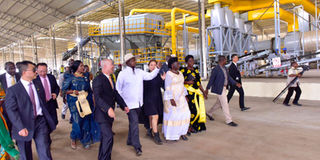Prime
Sukulu fertilisers set to hit stores soon

President Yoweri Museveni commissions the Sukulu comprehensive development project outside Tororo town in Eastern Uganda last month. Photo by Abu Mwesigwa
What you need to know:
- The project developer of the Shs2.2 trillion Sukulu development project outside Tororo town expects to roll out the first Ugandan made fertilisers on December 1, writes Frederic Musisi.
Uganda Revenue Authority estimates show that 74,174 tonnes of fertilisers have been imported so far this year with an import bill of $29m (Shs112b), a slight reduction of 5,702 tonnes of what was imported in 2017 at Shs101b ($27m).
Five years ago, fertiliser imports stood at 53,444 tonnes and cost Shs188b ($50m). But the volume declined to 44,111 tonnes in 2014 and again picked up at 60,888 tonnes in 2015 and subsequently declined to 68 tonnes in 2016.
Fertiliser imports have been fluctuating, at least over the last five years due to demand. The National Fertiliser Policy, however, indicates that current imported volumes are still way below the required one million tonnes annually.
Guangzhou Dongsong Energy Uganda Ltd, the Chinese company developing the Sukulu industrial complex, says they have done a market analysis on fertliser demand and usage, and their mathematics checks vis-à-vis prevailing circumstances.
The company’s chief Jane Guo told Prosper in an interview last week that the fertiliser manufacturing plant with installed capacity of 300,000 will be operating early December. It is expected to start with 5,000 tonnes for early production.
“What is imported is mostly expensive, and not so many people can afford it,” Ms Guo said, adding, “We are working on price adjustments to sit where we can fit in.”
The Sukulu comprehensive industrial complex situated within the Uganda-China Guangdong free zone of international cooperation which was flagged off in August by Finance minister Matia Kasaija, has been heralded by government as a “game changer”—bringing bio organic fertiliser production home and its related economies of scale.
The brick baking plant with daily capacity of 10,000 bricks is already running.
The steel and glass plant are expected on board by next July. Ms Guo said plant machinery has already been procured and is currently under engineering in China, where almost 60 percent of the total investment package of $620m (Shs2.2 trillion) has been spent.
Local fertiliser manufacturing is a game changer: from production associated economies of scale including employment of about 1,400 natives currently, and it could rise.
The agriculture sector, which according to the last national head count employs 70 percent of the population, different assessments have showed is declining in productivity which is attributed to among other factors, nutrient export through failure to embrace modern farming methods including usage of fertilisers.
Recent research by Makerere University based Economic Policy Research Centre showed that Uganda’s annual soil nutrient depletion rate stands at an average of 87 Kilogrammes (kg) of nutrients—nitrogen (N), phosphorus (P) and potassium (K) or NPK per hectare per year: roughly loss of 38Kg of N; 17Kgs of P and 32Kg of K— due to top soil erosion.
But application of fertilisers is estimated about 2Kg of nutrients per hectare per year which is low compared to the desirable average of 200Kg per hectare.
Most agriculture is subsistence based. Given the extent of poverty, most farmers cannot afford fertilisers. While it is unclear how DongSong will price its product, local production usually does not mean low prices.
A 2015 research by EPRC showed that at least eight in every ten 50Kg of inorganic fertiliser bags on the Ugandan market did not meet the minimum quality standards. This means either overseas manufacturers produce low-nutrient fertiliser or the importers went for the very cheap.
Given such dynamics, DongSong is thus keenly looking at markets in neihbouring countries—Kenya, Rwanda, Tanzania, and Rwanda. Kenya’s usage of fertilisers per hectare stands at 32 kilogrammes while Rwanda and Tanzania’s stands at 29Kg and 6Kg per hectare, respectively.
DongSong says they have undertaken several “studies on the suitability” of seven types of bio-organic fertilisers for among other crops such as maize, tea and tobacco around the country.
The ministry of Agriculture’s ministerial policy for this financial year hinted on rolling out a new fertiliser subsidy scheme to increase agricultural production in the country.
The pilot stages of the fertiliser e-voucher subsidy the statement indicated would have ten thousand farming households given fertiliser subsidies with targeted farmers receiving a card to access fertilisers at half the original cost then government would reimburse the fertiliser distributor.
Ms Guo said they are working with the ministry of agriculture, Makerere University and the National Agricultural Research Organisation (NARO), particularly on rolling out fertiliser demonstration firms.
This is where local production comes in handy but several questions linger on local absorption capacity.
Sukulu factory
The Sukulu industrial complex includes a fertiliser manufacturing plant, a brick baking plant, a steel and glass manufacturing plant, the maintenance centre which will supply spare parts for all plant machinery. It will also produce agricultural tools such as hoes and rakes.




